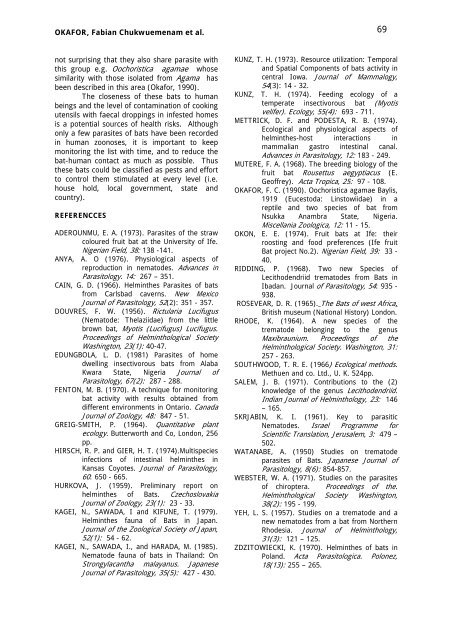Length-weight relationship of fishes from Anambra ... - Zoo-unn.org
Length-weight relationship of fishes from Anambra ... - Zoo-unn.org
Length-weight relationship of fishes from Anambra ... - Zoo-unn.org
- No tags were found...
Create successful ePaper yourself
Turn your PDF publications into a flip-book with our unique Google optimized e-Paper software.
OKAFOR, Fabian Chukwuemenam et al.69not surprising that they also share parasite withthis group e.g. Oochoristica agamae whosesimilarity with those isolated <strong>from</strong> Agama hasbeen described in this area (Okafor, 1990).The closeness <strong>of</strong> these bats to humanbeings and the level <strong>of</strong> contamination <strong>of</strong> cookingutensils with faecal droppings in infested homesis a potential sources <strong>of</strong> health risks. Althoughonly a few parasites <strong>of</strong> bats have been recordedin human zoonoses, it is important to keepmonitoring the list with time, and to reduce thebat-human contact as much as possible. Thusthese bats could be classified as pests and effortto control them stimulated at every level (i.e.house hold, local government, state andcountry).REFERENCCESADEROUNMU, E. A. (1973). Parasites <strong>of</strong> the strawcoloured fruit bat at the University <strong>of</strong> Ife.Nigerian Field, 38: 138 -141.ANYA, A. O (1976). Physiological aspects <strong>of</strong>reproduction in nematodes. Advances inParasitology. 14: 267 – 351.CAIN, G. D. (1966). Helminthes Parasites <strong>of</strong> bats<strong>from</strong> Carlsbad caverns. New MexicoJournal o f Parasitology, 52(2): 351 - 357.DOUVRES, F. W. (1956). Rictularia Lucifugus(Nematode: Thelaziidae) <strong>from</strong> the littlebrown bat, Myotis (Lucifugus) Lucifugus.Proceedings <strong>of</strong> Helminthological SocietyWashington, 23(1): 40-47.EDUNGBOLA, L. D. (1981) Parasites <strong>of</strong> homedwelling insectivorous bats <strong>from</strong> AlabaKwara State, Nigeria Journal <strong>of</strong>Parasitology, 67(2): 287 - 288.FENTON, M. B. (1970). A technique for monitoringbat activity with results obtained <strong>from</strong>different environments in Ontario. CanadaJournal <strong>of</strong><strong>Zoo</strong>logy, 48: 847 - 51.GREIG-SMITH, P. (1964). Quantitative plantecology. Butterworth and Co, London, 256pp.HIRSCH, R. P. and GIER, H. T. (1974).Multispeciesinfections <strong>of</strong> intestinal helminthes inKansas Coyotes. Journal <strong>of</strong> Parasitology,60: 650 - 665.HURKOVA, J. (1959). Preliminary report onhelminthes <strong>of</strong> Bats. CzechoslovakiaJournal <strong>of</strong><strong>Zoo</strong>logy, 23(1): 23 - 33.KAGEI, N., SAWADA, I and KIFUNE, T. (1979).Helminthes fauna <strong>of</strong> Bats in Japan.Journal o f the <strong>Zoo</strong>logical Society <strong>of</strong> Japan,52(1): 54 - 62.KAGEI, N., SAWADA, I., and HARADA, M. (1985).Nematode fauna <strong>of</strong> bats in Thailand: OnStrongylacantha malayanus. JapaneseJournal o f Parasitology, 35(5): 427 - 430.KUNZ, T. H. (1973). Resource utilization: Temporaland Spatial Components <strong>of</strong> bats activity incentral Iowa. Journal <strong>of</strong> Mammalogy,54(3): 14 - 32.KUNZ, T. H. (1974). Feeding ecology <strong>of</strong> atemperate insectivorous bat (Myotisvelifer). Ecology, 55(4): 693 - 711.METTRICK, D. F. and PODESTA, R. B. (1974).Ecological and physiological aspects <strong>of</strong>helminthes-host interactions inmammalian gastro intestinal canal.Advances in Parasitology, 12: 183 - 249.MUTERE, F. A. (1968). The breeding biology <strong>of</strong> thefruit bat Rousettus aegyptiacus (E.Ge<strong>of</strong>frey). Acta Tropica, 25: 97 - 108.OKAFOR, F. C. (1990). Oochoristica agamae Baylis,1919 (Eucestoda: Linstowiidae) in areptile and two species <strong>of</strong> bat <strong>from</strong>Nsukka <strong>Anambra</strong> State, Nigeria.Miscellania <strong>Zoo</strong>logica, 12: 11 - 15.OKON, E. E. (1974). Fruit bats at Ife: theirroosting and food preferences (Ife fruitBat project No.2). Nigerian Field, 39: 33 -40.RIDDING, P. (1968). Two new Species <strong>of</strong>Lecithodendriid trematodes <strong>from</strong> Bats inIbadan. Journal <strong>of</strong> Parasitology, 54: 935 -938.ROSEVEAR, D. R. (1965). The Bats o f west Africa.British museum (National History) London.RHODE, K. (1964). A new species <strong>of</strong> thetrematode belonging to the genusMaxibraunium. Proceedings <strong>of</strong> theHelminthological Society. Washington, 31 :257 - 263.SOUTHWOOD, T. R. E. (1966) Ecological methods.Methuen and co. Ltd., U. K. 524pp.SALEM, J. B. (1971). Contributions to the (2)knowledge <strong>of</strong> the genus Lecithodendriid.Indian Journal <strong>of</strong> Helminthology, 23: 146– 165.SKRJABIN, K. I. (1961). Key to parasiticNematodes. Israel Programme forScientific Translation, Jerusalem, 3: 479 –502.WATANABE, A. (1950) Studies on trematodeparasites <strong>of</strong> Bats. Japanese Journal o fParasitology, 8(6 ): 854-857.WEBSTER, W. A. (1971). Studies on the parasites<strong>of</strong> chiroptera. Proceedings <strong>of</strong> the.Helminthological Society Washington,38(2 ): 195 - 199.YEH, L. S. (1957). Studies on a trematode and anew nematodes <strong>from</strong> a bat <strong>from</strong> NorthernRhodesia. Journal <strong>of</strong> Helminthology ,31(3 ): 121 – 125.ZDZITOWIECKI, K. (1970). Helminthes <strong>of</strong> bats inPoland. Acta Parasitologica. Polonez,18(13): 255 – 265.

















